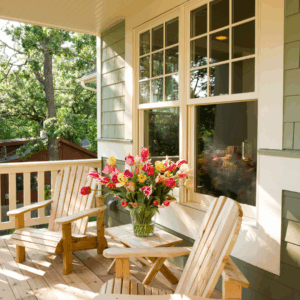
By Tyler Plack
Tyler Plack is the President of South River Mortgage. Tyler holds an active FHA Direct Endorsement (DE) underwriting certification and is the author of The Retirement Solution: Maximizing Your BenefitTyler is a seasoned entrepreneur and real estate investor renowned for his expertise in reverse mortgages and his commitment to addressing seniors' equity challenges. Tyler brings a unique perspective to his ventures, having built several successful companies throughout his career. His insights are frequently sought by industry publications, where he is recognized for his vast knowledge in the realm of reverse mortgages.
An avid investor in income-producing properties, Tyler is dedicated to helping seniors navigate their financial needs with compassion and expertise. When Tyler is not helping solve America's retirement crisis, he is a skilled pilot flying airplanes for fun.
Many retirees hope to remain in their homes for the rest of their lives. Some begin to discover that they no longer need their large home, but selling one home and buying another seems like too much of a hassle.
However, if you want to downsize, there’s an easier way: a reverse mortgage for purchase. Here’s a closer look.
Who Can Benefit Most from a HECM for Purchase
A HECM for Purchase is best for people who want a smaller home and no monthly mortgage bill.
It’s especially helpful for those who:
- Own their current home outright or have a lot of equity
- Want to move closer to family or into a single-level home
- Hope to lower housing costs and upkeep
- Prefer to keep extra cash for travel, health care, or savings
Because you don’t make monthly payments, your retirement income can stretch further — giving you more freedom and less stress.
What’s a Reverse Mortgage for Purchase?
A reverse mortgage for purchase is a unique transaction that allows you to partially finance a home purchase with a reverse mortgage. It’s also known as a home equity conversion mortgage (HECM) for purchase.
A reverse mortgage for purchase is only possible if you can make a substantial down payment, usually around 50%. In the same transaction, you take out a reverse mortgage to finance the remaining balance.
Just as with any other reverse mortgage, you won’t owe monthly mortgage payments. The balance on the reverse mortgage is due when you die, sell the house, or move.
Likewise, if you’re considering this option, you must meet all of the eligibility requirements for reverse mortgages in general. These include being at least 62, maintaining the home as your primary residence, and continuing to pay homeowners’ insurance premiums and property taxes.
Downsizing With a Reverse Mortgage for Purchase
If you’re not already familiar with the concept, the idea of a reverse mortgage for purchase can be difficult to wrap your head around. Here’s a step-by-step look at how to downsize with a HECM for purchase:
Step 1: Sell Your Existing Home
You’ll need to use the proceeds from the sale of your current home to put a down payment on a newer, smaller home.
Step 2: Choose Your New Home and Get Approved
You will need to get approved for a reverse mortgage for purchase. It’s important to work with a lender who is familiar with the process. Your loan officer will be able to help you understand what kind of home you can reasonably afford.
Step 3: Use the Sale Proceeds for a Down Payment
Once you’ve found a smaller home you like, you can make your down payment. Most standard reverse mortgages require you to have at least 50% equity in your home, so most reverse mortgages for purchase require a 50% down payment.
Step 4: Finance the Rest with a Reverse Mortgage
Technically, this step is part of the same transaction. You take out a reverse mortgage against your equity in the home (your down payment) and use it to pay for the rest of the home. If you have remaining sale proceeds from your previous home, you can put them toward your retirement income.

Example – How Downsizing with a HECM Works
Let’s say you sell your current home for $600,000 and find a smaller place for $400,000.
Here’s how that could look:
- Down payment (about 50%): $200,000 from the sale
- Reverse mortgage covers the other $200,000
- Money left over: $600,000 – $400,000 = $200,000 in savings
That $200,000 stays in your pocket. You can use it for living expenses, health care, or to enjoy retirement.
And because you used a HECM, you’ll never make a monthly mortgage payment as long as you live in the new home.
Eligible Property Types for a HECM for Purchase
Not every home qualifies for a reverse mortgage purchase, so it helps to know what does.
You can use a HECM for Purchase to buy:
- A single-family house
- An FHA-approved condo
- A townhouse or duplex (if you live in one unit full-time)
- A newly built home that’s fully finished before closing
Mobile homes and second homes usually don’t qualify. Checking early helps avoid delays later.
Are You Eligible for a Reverse Mortgage?
(Find out in 60 seconds)
What Are Some of the Benefits of Downsizing with a Reverse Mortgage for Purchase?
A reverse mortgage for purchase simplifies the downsizing process, but there’s still a fair bit of effort involved. However, many seniors determine that it’s well worth it. These are some key benefits:
No Mortgage Payments
This is one of the most important advantages of this strategy. When you don’t have to pay a mortgage each month, you can enjoy greater stability.
More Cash for Retirement
Because you’re selling a larger home to buy a smaller one, you’ll almost certainly have funds remaining after your 50% down payment. You can use these funds to support yourself in retirement.
Saving Money on Routine Costs of Homeownership
Even when you own a home outright, you still need to pay for maintenance, utilities, and property taxes. When you have a smaller, less costly home, these expenses are often substantially lower.

Key Advantages Over Paying Cash or Getting a Traditional Mortgage
You could buy your next home with cash or take out a regular mortgage, but a HECM for Purchase often works better:
| Option | Monthly Payment | Upfront Cash Needed | Cash Left for Retirement |
| Pay Cash | $0 | 100% of price | $0 left |
| Traditional Mortgage | Required | Around 20% | Less available |
| HECM for Purchase | $0 | About 50% | About half your savings left |
A HECM for Purchase gives you the best of both worlds — no monthly payment and more money left in savings — while you stay the full owner of your home.
Common Misconceptions About Downsizing with a HECM
“I’ll lose ownership of my new home.”
Not true. You keep the title and can sell or move anytime.
“My family will have to pay off my loan.”
No. A HECM is a special kind of loan that never leaves debt to your heirs.
“This is only for people with money problems.”
Also false. Many retirees use HECMs to make smart financial moves — freeing up money for the things they enjoy.
Knowing the facts helps you feel confident about your decision.
Is a Reverse Mortgage for Purchase Right for You?
Everyone’s retirement looks a little different — and what works for one person might not work for another. A reverse mortgage for purchase can be a smart move for some, but it’s not the right fit for everyone. That’s why it’s so important to take your time, do your homework, and explore all your options before making a decision. Take a minute to see how much equity you can unlock with our reverse mortgage calculator.
Thinking about a reverse mortgage for purchase? We’re here to help. Our team knows the ins and outs of reverse mortgages and can walk you through how they work
Contact us here, and let’s get started.
FAQ – Downsizing with a HECM for Purchase
Do I have to sell my current home first?
Yes. You’ll use that money for the down payment on your next home.
Can I buy a condo or new construction with a HECM?
Yes, as long as the condo is FHA-approved and the home is finished before closing.
What if I move again later?
You can sell the home, pay off the reverse mortgage, and keep any remaining equity.
Does the new home have to be my main home?
Yes. You must live there most of the year for the loan to stay active.
How long does it take to close?
Most HECM for Purchase loans close in about 30 to 45 days, just like a normal home sale.



